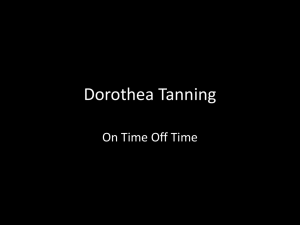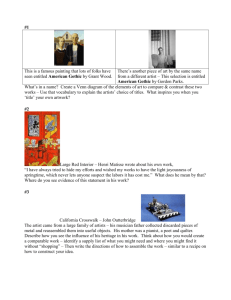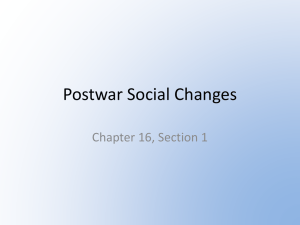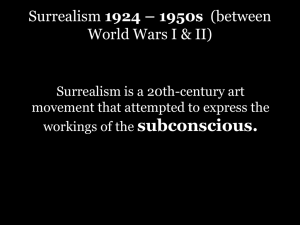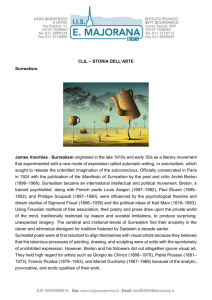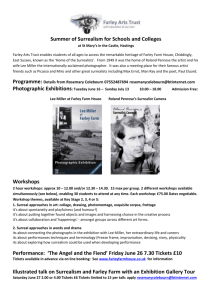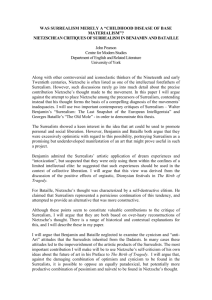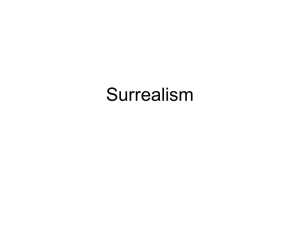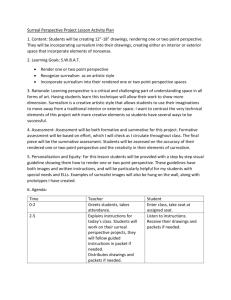What's New in the Surreal World
advertisement
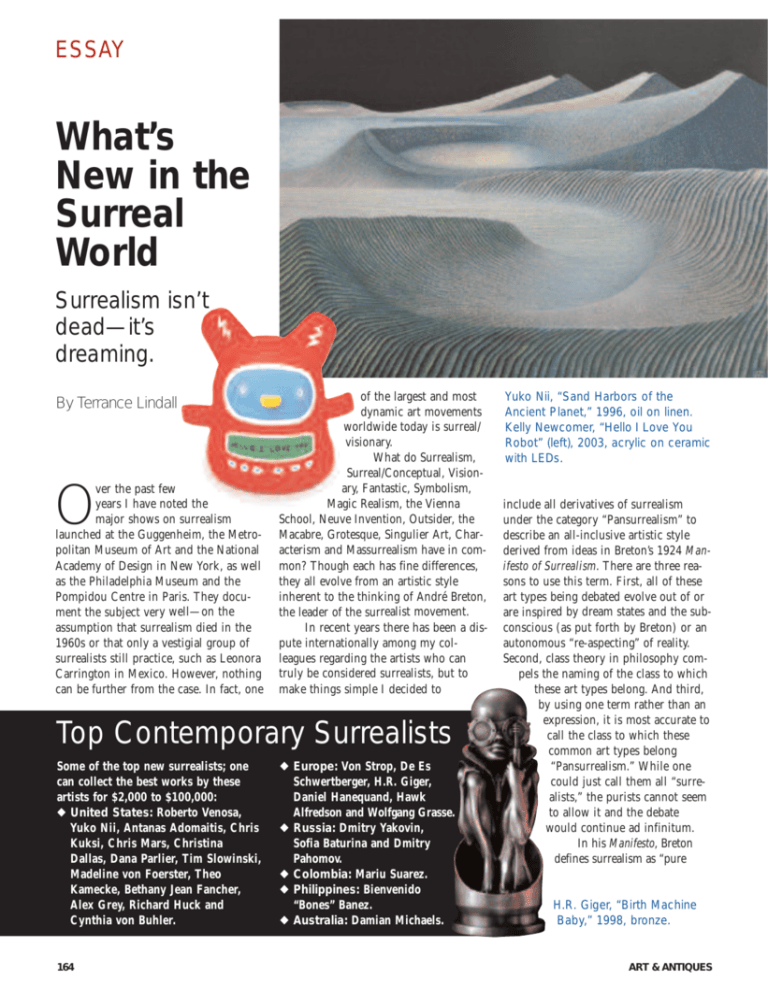
ESSAY What’s New in the Surreal World Surrealism isn’t dead—it’s dreaming. By Terrance Lindall ver the past few years I have noted the major shows on surrealism launched at the Guggenheim, the Metropolitan Museum of Art and the National Academy of Design in New York, as well as the Philadelphia Museum and the Pompidou Centre in Paris. They document the subject very well—on the assumption that surrealism died in the 1960s or that only a vestigial group of surrealists still practice, such as Leonora Carrington in Mexico. However, nothing can be further from the case. In fact, one O of the largest and most dynamic art movements worldwide today is surreal/ visionary. What do Surrealism, Surreal/Conceptual, Visionary, Fantastic, Symbolism, Magic Realism, the Vienna School, Neuve Invention, Outsider, the Macabre, Grotesque, Singulier Art, Characterism and Massurrealism have in common? Though each has fine differences, they all evolve from an artistic style inherent to the thinking of André Breton, the leader of the surrealist movement. In recent years there has been a dispute internationally among my colleagues regarding the artists who can truly be considered surrealists, but to make things simple I decided to Top Contemporary Surrealists Some of the top new surrealists; one can collect the best works by these artists for $2,000 to $100,000: u United States: Roberto Venosa, Yuko Nii, Antanas Adomaitis, Chris Kuksi, Chris Mars, Christina Dallas, Dana Parlier, Tim Slowinski, Madeline von Foerster, Theo Kamecke, Bethany Jean Fancher, Alex Grey, Richard Huck and Cynthia von Buhler. 164 u Europe: Von Strop, De Es Schwertberger, H.R. Giger, Daniel Hanequand, Hawk Alfredson and Wolfgang Grasse. u Russia: Dmitry Yakovin, Sofia Baturina and Dmitry Pahomov. u Colombia: Mariu Suarez. u Philippines: Bienvenido “Bones” Banez. u Australia: Damian Michaels. Yuko Nii, “Sand Harbors of the Ancient Planet,” 1996, oil on linen. Kelly Newcomer, “Hello I Love You Robot” (left), 2003, acrylic on ceramic with LEDs. include all derivatives of surrealism under the category “Pansurrealism” to describe an all-inclusive artistic style derived from ideas in Breton’s 1924 Manifesto of Surrealism. There are three reasons to use this term. First, all of these art types being debated evolve out of or are inspired by dream states and the subconscious (as put forth by Breton) or an autonomous “re-aspecting” of reality. Second, class theory in philosophy compels the naming of the class to which these art types belong. And third, by using one term rather than an expression, it is most accurate to call the class to which these common art types belong “Pansurrealism.” While one could just call them all “surrealists,” the purists cannot seem to allow it and the debate would continue ad infinitum. In his Manifesto, Breton defines surrealism as “pure H.R. Giger, “Birth Machine Baby,” 1998, bronze. ART & ANTIQUES ESSAY Madeline von Foerster, “Self Portrait,” 2005, oil and egg tempera on panel in wood frame. psychic automatism” by which it is intended to express, either verbally or in writing, the true function of thought— thought dictated in the absence of all control exerted by reason and outside of all moral preoccupations. In its purest form in the plastic arts, surrealism would be abstract expressionism; critic Clement Greenberg recognized this. However, Breton was most interested in the dream state. The dream is the important central sustaining foundation of what the surreal, visionary and fantastic are about. This is not specifically what the abstract expressionists are offering, but it is what the surreal/visionary and fantastic artists of what I call “The New International Surrealist Movement” (NISM) are pursuing in their art. In 2003 I produced “Brave Destiny,” the world’s largest show of works by living surrealists. Showcasing nearly 500 artists and held at the Williamsburg Art & Historical Center in Brooklyn, “Brave Destiny” expressed a broad notion of surrealism as an artistic style. It exhibited a preponderance of excellence in draftsmanship and composition. Most of these artists are admirers or followers of Ernst Fuchs, rediscoverer of the Misch technique used by 16thcentury masters. Classical rendering in oils has been disparaged recently by the nonrepresentational artists and their champions, especially of the New York School, resulting in the lack of representation in galleries in recent decades. Thus, visitors to “Brave Destiny” were astounded to see such skill. Today, surrealism has diversified, with installation art becoming a facet. Photography, which has been in use since the Golden Age, has now become a major expression of the new surrealists. Chris Mars, “A cleansing at Blue Bay,” 2004, oil on board. 166 Surrealism is also robust in the areas of dance, theater and film. The influence of surrealism in commercial mass media has been notable to everyone in the world of comics. Comics as we know them began to appear in 19th-century American Sunday newspaper supplements, starting with Richard Felton Outcault’s “The Yellow Kid.” Later, Winsor McCay’s masterpiece “Little Nemo in Slumberland” appeared—a character who would not seem out of place in any surrealism show. In Europe, the adult fantasy magazine Metal Hurlant (known as Heavy Metal in the United States), which appeared in the 1970s, became a massmedia outlet for surrealists, and artists such as Moebius, Rod Kierkegaard Jr. and Phillippe Druillet became well known. These comics have had a direct influence on artists working today in the commercial worlds of fashion, advertising, video games and the like, as well as the fine arts. Japanese “mass surrealism” (Manga) burst forth internationally as a global phenomenon in the contemporary art market initiated by a new generation of artists who were absorbed by Pop subcultures. Much the same way as Andy Warhol and Roy Lichtenstein were influenced by comics and advertising, many contemporary surrealist artists are incorporating ART & ANTIQUES ESSAY Robert Venosa, “Astral Circus,” 1976–78, oil on Masonite. images from a new and international phenomenon of pop culture—and not only cartoons and comics, but also electronic products like personal minicomputers and telecommunication products, such as Hello Kitty cell phones, Sony AIBO and Dream Robot. The animated filmmakers Hayao Miyazaki and Isao Takahata began to have broad international influence in the 1970s. Miyazaki’s themes of magical terrains and nature vs. man have influenced these new Pop surrealist fine artists. The first of this new wave of artists were Mariko Mori and Takashi Murakami from Japan. The tremendous influence of pop subculture of the 1960s through the 1990s resulted in a new “pop-surrealist” fine-art form called “Characterism,” a term coined by Yuko Nii of the Williamsburg Art & Historical Center and Yuko Wylie of Lunarbase Galley, both in Brooklyn, who sponsored in 2003 the first major show of 67 Pop fine artists whose works are based upon these comic mass-media art forms. Another group, the “Massurrealists” (a term coined by artist James Seehafer) are considered to be among the first new art movements of the 21st century. Those who grew up in the 1980s and ’90s witnessed the pervading influence of mass media, advertising, the advent of commercial uses for the Web. Professor Mark Daniel Cohen of European Graduate School in Saas-Fee, Switzerland, describes their works as follows: “Massurrealism is a burgeoning art movement in which artists employ the iconography and technologies of the mass media to achieve the principal aim of authentic Surrealism: a transformation of the state of mind of the viewer so as to initiate a perception of the dream-like truth of reality.” Ultimately, surrealism will be vindicated as the foundation of all modern and contemporary art forms. Surrealists seek to change the common way of looking at things. It is a revolution of the 168 mind against the ordinary. Surrealism is very much alive—and flourishing. v For More Information u Aaron Galleries, Chicago. (312) 9430660. u Art at Large, New York. (212) 9578371. u CFM Gallery, New York. (212) 9663864. u CVB Space, New York. (646) 3368387. u Dabora-Victorian Salon Gallery, Brooklyn, New York. (718) 609-9629. u Interart Gallery, New York. (212) 647-1811. u Jean Albano Gallery, Chicago. (312) 440-0770. u Limner Gallery, Phoenicia, N.Y. (845) 688-7129. u McCaig Welles Gallery, Brooklyn. (718) 384-8729. u Michael Rosenfeld Gallery, New York. (212) 247-0082. u Robert Henry Adams Fine Art, Chicago. (312) 642-8700. u Robert Miller Gallery, New York. (212) 366-4774. u The Dollhaus Gallery, Brooklyn. www.dollhaus.org. u Thomas McCormick Gallery, Chicago. (312) 226-6800. Surrealist artist and writer Terrance Lindall is president of the Williamsburg Art & Historical Center in Brooklyn, New York. ART & ANTIQUES
